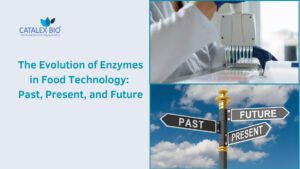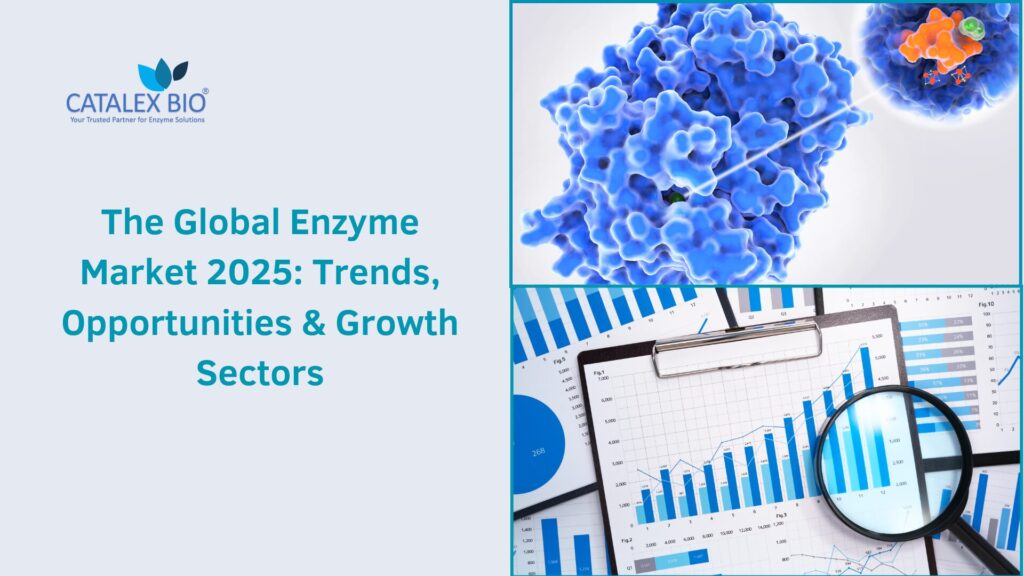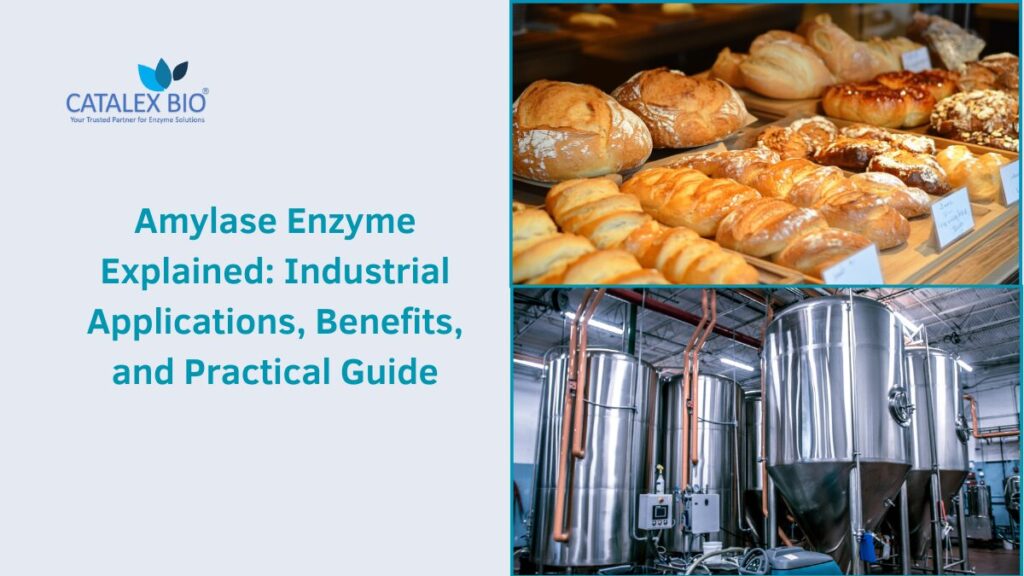Introduction: Why enzymes matter in food
Enzymes are nature’s catalysts—proteins (and a few RNAs) that make chemistry go faster, gentler, and vastly more specific. In food, they unlock sweetness from starch, clarify juices, tenderize meats, create cheese from milk, brighten flavors, and make bread lighter and longer-lasting. Because enzymes work under mild conditions (moderate temperatures, neutral pH, aqueous systems), they offer energy savings and cleaner processes compared with purely chemical routes. That makes them central to today’s push for sustainability and “clean-label” reformulation, and it’s why the next generation of enzyme design—spanning directed evolution and AI—is poised to reshape how we grow, process, and enjoy food.
At Catalex Bio, we believe in leveraging this natural power of enzymes to deliver innovative, sustainable, and high-performance solutions tailored to modern food challenges.
This article traces the arc from ancient craft to modern biotech: the discovery of enzymes, their industrialization in the 20th century, their pivotal roles across today’s food sectors, and the science, regulation, and engineering that will define their future.
A short primer: What enzymes are and how they work
At their core, enzymes lower the activation energy of reactions, steering substrates along highly specific pathways. Specificity matters enormously in food: you want an amylase that trims starch just enough for softness in bread; a lactase that splits lactose without generating off-flavors; a pectinase that clarifies juice without stripping aroma compounds. Most food enzymes are produced by fermentation using safe microbial hosts, then purified to meet strict specifications on identity, activity, and purity. Internationally, risk assessors such as the Joint FAO/WHO Expert Committee on Food Additives (JECFA) have long set the template for how enzyme preparations are specified and evaluated, and regulators require that enzymes be safe, technologically justified, and not misleading to consumers.
From craft to science: A brief history of enzymes in food
Ancient beginnings (long before the name “enzyme”)
Long before anyone knew what an enzyme was, people were harnessing enzyme activities: sprouted grains (rich in diastatic enzymes) to start bread; rennet from calf stomach to coagulate milk; molds and yeasts to ferment soy sauces, wines, and beers. These were empirical arts that relied on living cultures and crude extracts.
The scientific turn (1833–1926)
- 1833: Anselme Payen and Jean-François Persoz isolate “diastase” from malted barley—the first enzyme ever described—capable of converting starch to sugars.
- 1897: Eduard Buchner shows that cell-free yeast extracts ferment sugar to alcohol, proving that enzymes can act outside living cells and kickstarting modern biochemistry (Nobel Prize, 1907).
- 1926: James B. Sumner crystallizes urease, demonstrating that enzymes are proteins—a landmark that turns enzyme chemistry into a structural science (Nobel Prize, 1946).
Industrialization and the recombinant era (mid-1900s onward)
By the mid-20th century, enzyme production scaled via microbial fermentation (fungi, bacteria), enabling consistent supplies for brewing, baking, and starch processing. A milestone came in 1990, when the U.S. FDA affirmed recombinant chymosin (fermentation-produced calf rennet) as safe—the first widely used bioengineered enzyme in food. Within a few years, recombinant chymosin dominated cheesemaking because it matched animal rennet’s performance but offered supply reliability and purity.
The present: Where enzymes power today’s food system
1) Dairy: coagulation, lactose-free, and flavor
- Milk coagulation: Chymosin (animal-derived or recombinant) cleaves κ-casein to form curds for cheese. Microbial lipases and proteases aid flavor development in certain styles, accelerating ripening and generating characteristic notes.
- Lactose hydrolysis: β-Galactosidase (lactase) splits lactose into glucose and galactose to make lactose-free dairy. Hydrolysis also raises perceived sweetness (glucose and galactose taste sweeter than lactose), enabling sugar reduction strategies in flavored milk and yogurt. Immobilized lactase in packed-bed reactors supports continuous processing.
2) Baking: dough conditioning, volume, softness, and shelf life
Modern bread quality is a choreography of enzymes:
- Amylases (fungal α-amylase; maltogenic amylase) adjust crumb softness and delay staling by modifying starch.
- Xylanases remodel arabinoxylans in flour, improving gas retention and loaf volume.
- Glucose oxidase strengthens dough via oxidative cross-linking effects.
- Lipases can generate emulsifier-like lipids in situ, supporting “clean-label” reductions of added emulsifiers.
Collectively, these enzymes allow consistent doughs across flour variability and extend softness during shelf life, central to industrial baking.
3) Brewing and wine making: extract efficiency and clarity
- In brewing, α-amylases, glucanases, and proteases improve mash filtration, extract yield, and foam stability. Enzymes allow adjunct use (e.g., unmalted cereals) and help manage viscosity from β-glucans. Proteases like papain have been used to mitigate chill haze by breaking down haze-forming proteins.
- In wine and juice, pectinases (often with cellulases/hemicellulases) aid maceration, color extraction in red wines, clarification, and filterability in juices, with careful dose-response work to preserve desirable aromas.
4) Starch processing & sweeteners: from liquefaction to HFCS
A canonical enzyme train turns starch into tailored syrups:
- α-Amylase liquefies gelatinized starch.
- Glucoamylase (often with pullulanase) saccharifies to glucose.
- Glucose isomerase converts glucose to fructose, producing high-fructose corn syrup (HFCS), a mainstay sweetener. The first U.S. shipments of enzymatically made fructose syrups date to 1967, and the technology matured with immobilized isomerase reactors.
5) Meat and seafood: texture engineering
Transglutaminase (“TG”) catalyzes protein cross-links (ε-(γ-glutamyl)-lysine), improving texture and binding in structured meats, seafood, and dairy gels. Safety assessments in the EU show a nuanced picture: several TG preparations have been assessed as safe under intended uses when exposure margins are adequate, while others have not met safety thresholds in specific evaluations—underscoring that safety conclusions depend on the source, manufacturing, and exposure estimates for each product. Labeling rules vary by jurisdiction and application (ingredient vs. processing aid).
6) Process contaminants: cutting acrylamide with asparaginase
When starchy foods are heated, acrylamide can form via the Maillard reaction between asparagine and reducing sugars. L-Asparaginase helps by hydrolyzing asparagine before it reacts, and it’s now a mainstream mitigation step in cereals, snacks, and potato products. The EU’s mitigation regulation (2017/2158) lists enzymatic approaches among measures food businesses can adopt alongside recipe and process controls.
Case studies across categories
Baking: softer crumb and longer freshness without “chemical-sounding” additives
Artisan bakers once relied on long fermentation to condition dough. Industrial bakers, tasked with scale and consistency, use xylanases to modulate arabinoxylans, maltogenic amylases to slow staling by trimming amylopectin branches, glucose oxidase for oxidative strengthening, and lipases to generate monoglyceride-like emulsifiers in situ. The result: improved volume, resilience, and softness across shelf life—often supporting “clean-label” ambitions.
Cheese: recombinant chymosin becomes the norm
Scarcity and variability of animal rennet motivated the 1990s shift to fermentation-produced chymosin (FPC). Biotechnological production offers purity, consistent activity, and stable supply—and because the enzyme is functionally identical to calf chymosin, cheesemaking parameters remain familiar. Safety assessments and regulatory clearances established a template that subsequent food enzymes have followed.
Juice and wine: gentle clarity and color management
Pectinases break down pectic substances that otherwise trap juice and clog filters. In red winemaking, tailored blends help with skin maceration and color extraction; in whites and juices, they accelerate clarification and filtration, reducing energy and time with minimal impact on aroma when properly dosed.
HFCS: immobilized isomerase at industrial scale
Today’s HFCS plants illustrate enzyme engineering in action: immobilized glucose isomerase columns convert glucose to fructose under controlled conditions, the catalyst is reused for long periods, and reactor designs have been refined over decades. Historian snapshots put the first U.S. fructose syrup shipments at 1967, followed by rapid growth as immobilization and process intensification increased yields and cut costs.
Acrylamide: practical mitigation with asparaginase
Snack makers and cereal processors deploy L-asparaginase upstream of high-temperature steps to reduce asparagine pools. It’s not a silver bullet (process and recipe still matter), but it’s a powerful lever in a multi-measure program under Europe’s mitigation regulation.
Consumer trends and “clean label”: What enzymes enable (and don’t)
Enablers: Enzymes allow manufacturers to reduce or replace certain additives (e.g., emulsifiers) by generating functionality during processing, bolster plant-based formulations (e.g., proteases to improve texture; lipases/esterases to shape fat profiles), and lower process severity (gentler temperatures, shorter times). In lactose-free dairy, lactase removes a dietary barrier while enhancing perceived sweetness, enabling sugar reduction.
Limits: Enzymes aren’t magic. They can create off-flavors if over-used (e.g., excessive proteolysis), may raise allergen considerations (e.g., egg-derived lysozyme in specialty uses), and don’t negate the need for hygienic design or thermal lethality steps. And while some are treated as processing aids for labeling, regulations differ by market and application.
The near future: Five developments to watch
1) Precision fermentation and novel enzyme sources
Fermentation platforms are expanding beyond traditional hosts, including yeasts and filamentous fungi engineered for higher secretion, better glycosylation control, and safer profiles. Metagenomics and enzyme mining are surfacing extremozymes with unusual pH/temperature tolerance—handy for baking and frying environments.
2) AI-guided design meets directed evolution
Structure-informed, ML-prioritized mutagenesis can shrink screening libraries by orders of magnitude, letting teams target stability, pH optima, or substrate scope with fewer wet-lab rounds. Expect a steady pipeline of enzymes tuned for specific flours, oils, dairy matrices, and plant-based proteins.
3) Enzymes for plant-based and alternative proteins
Proteases tailored to reduce bitterness (from hydrophobic peptides), transglutaminases to build gel networks, and lipases to generate dairy-like volatiles are enabling more realistic textures and flavors in alt-dairy and alt-meat. As companies move from commodity to curated proteins, enzyme portfolios will get more bespoke.
4) Continuous, modular “enzymatic unit ops”
Think plug-and-play enzyme cartridges—immobilized modules for lactose hydrolysis, juice depectinization, oil interesterification, or sugar tailoring, integrated with inline analytics and smart controls. Continuous operation reduces batch variability and energy per kg.
5) Safety, exposure science, and transparency
Expect continued maturation of exposure models (better consumption data, realistic TOS carryover), broader adoption of qualified presumption of safety (QPS) concepts for production strains, and clearer public communication on what enzymes do and why they’re used. In the EU, the long-anticipated Union list will consolidate authorizations once EFSA’s evaluations conclude; in the U.S., GRAS practice and processing-aid policies will continue to shape how enzymes appear (or don’t) on labels.
Safety and regulation: How enzymes are approved and controlled
Global risk assessment foundations
Food enzyme preparations are evaluated for source safety, identity, purity, potential toxicology (including allergenicity), and dietary exposure. JECFA monographs and compendia describe how enzyme preparations are specified and assessed, influencing many national and regional systems. Specifications commonly set activity units, contaminants/microbiological criteria, and carryover limits for total organic solids (TOS).
United States
In the U.S., many food enzymes are cleared through the GRAS (Generally Recognized As Safe) pathway, where safety is established by scientific procedures. The FDA maintains a GRAS Notice inventory and issues no-questions letters when the evidence is sufficient. Enzymes often qualify as processing aids, meaning they perform a technological function during processing with no (or negligible) function in the final food, which affects labeling in practice.
European Union
Regulation (EC) No 1332/2008 created the EU framework for food enzymes: all enzymes require an EFSA safety evaluation and Commission approval for inclusion on a Union list; only enzymes on that list may be placed on the market once the list is in force. The Commission maintains a Register of applications submitted during the 2011–2015 window and EFSA continues to publish opinions. As of the latest official communications, the Union list is to be adopted after evaluations conclude; in the meantime, national rules can apply. This transitional status explains why you still see EFSA opinions while the central list is pending.
Practical guidance for teams adopting enzymes
- Start with the product goal, not the enzyme name. Define crumb softness, filtration time, yield, or flavor target quantitatively. Then screen enzyme classes and suppliers against that spec.
- Map the process constraints (pH, temperature, water activity, salts, sugars) and match the enzyme’s stability/optima accordingly.
- Design dose–response trials and watch for second-order effects (e.g., proteases can impact foam; pectinases can influence aroma retention).
- Plan deactivation (bake-out, pasteurization) if needed to stop reactions after the desired endpoint.
- Check regulatory status in destination markets (GRAS letters, EFSA opinions, national rules during EU transition) and document your exposure assessments.
Conclusion: A maturing science with a creative future
Enzymes have always sat at the intersection of biology and food craft. What’s changed is our ability to choose, tune, and deploy them with precision. From Payen’s diastase to recombinant chymosin, from immobilized isomerase columns to AI-guided design, each step has made food processing more efficient, more sustainable, and more tailored to consumer needs. The next decade will likely be less about discovering that an enzyme works and more about engineering the best enzyme for a narrowly defined job—then running it in continuous, instrumented processes that squeeze out waste and variation. If history is any guide, the biggest leaps will come from coupling biology’s specificity with engineering discipline—and telling a transparent story about why enzymes belong in modern, responsible food making
Partner with Catalex Bio
At Catalex Bio, we are committed to driving this next chapter of enzyme innovation—helping food manufacturers worldwide unlock efficiency, sustainability, and clean-label excellence. Connect with us today to explore tailored enzyme solutions for your products and processes.




Pingback: Global Enzyme Market 2025 Insights | Catalex Bio